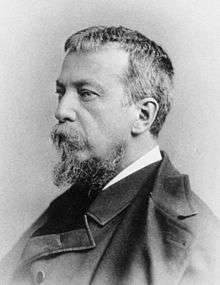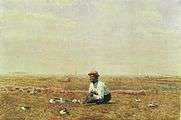Silas Weir Mitchell (physician)
Silas Weir Mitchell (February 15, 1829 – January 4, 1914) was an American physician, scientist, novelist, and poet. He is considered the father of medical neurology, and he discovered causalgia (complex regional pain syndrome) and erythromelalgia, and pioneered the rest cure.
Silas Weir Mitchell | |
|---|---|
 | |
| Born | Silas Weir Mitchell February 15, 1829 Philadelphia, Pennsylvania |
| Died | January 4, 1914 (aged 84) Philadelphia, Pennsylvania |
| Alma mater | Jefferson Medical College |
| Known for | neurology research |
Biography
Silas Weir Mitchell was born on February 15, 1829, in Philadelphia, Pennsylvania, to John Kearsley Mitchell and Sarah Henry Mitchell.
He studied at Philadelphia's renowned University of Pennsylvania and later earned the degree of MD at the city's Jefferson Medical College in 1850. During the Civil War, he was director of treatment of nervous injuries and maladies at Turners Lane Hospital, Philadelphia, and at the close of the war became a specialist in neurology. In this field Mitchell pioneered the rest cure for diseases now termed "psychiatric", particularly neurasthenia and hysteria, subsequently taken up by the medical world.[1] The treatment consisted primarily in isolation, confinement to bed, dieting, electrotherapy and massage; and was popularly known as 'Dr Diet and Dr Quiet'.[1] Mitchell advocated a high-fat diet to his patients.[2][3] He believed that a diet rich in fat would "fatten and redden" his patients, leading to a cure. To achieve this, large quantities of milk were prescribed. He requested his patients to consume two quarts or more milk a day.[4]
His medical texts include Injuries of Nerves and Their Consequences (1872) and Fat and Blood (1877). Mitchell's disease (erythromelalgia) is named after him. He also coined the term phantom limb during his study of an amputee.[5] Mitchell discovered and treated causalgia (today known as CRPS/RSD), a condition most often encountered by hand surgeons. Mitchell is considered the father of medical neurology and a pioneer of "evidence-based" or "scientific" medicine. He was also a psychiatrist, toxicologist, author, poet, and celebrity in Europe as well as America. His contemporaries considered him a genius no less than Benjamin Franklin.
In 1866, he published a short story in the Atlantic Monthly resting upon both somatic and psychological insights entitled "The Case of George Dedlow".[6] From that point onward, Mitchell divided his attention between scientific and literary pursuits. In the former field, he produced monographs on rattlesnake venom, intellectual hygiene, injuries to the nerves, neurasthenia, nervous diseases of women, the effects of gunshot wounds upon the nervous system, and relations between nurse, physician, and patient; in the latter, he wrote juvenile stories, several volumes of respectable verse (The Hill of Stones and Other Poems was published in 1883 by Houghton, Mifflin and Co.), and prose fiction of varying merit, which earned him a leading place among American authors at the close of the 19th century. His historical novels in particular, notably Hugh Wynne (1897), The Adventures of François (1898), The Youth of Washington (1904), and The Red City (1909), are among the best of their genre.
He died on January 4, 1914 in Philadelphia and is interred at The Woodlands Cemetery.[7]
Prominent patients
He was Charlotte Perkins Gilman's doctor and his use of a rest cure on her provided the idea for "The Yellow Wallpaper", a short story in which the narrator is driven insane by this treatment.
His treatment was also used on Virginia Woolf, who wrote a savage satire of it in her novel Mrs. Dalloway (1925): "you invoke proportion; order rest in bed; rest in solitude; silence and rest; rest without friends, without books, without messages; six months rest; until a man who went in weighing seven stone six comes out weighing twelve".[8]
Influence on Freud
Sigmund Freud reviewed Mitchell's book on The Treatment of Certain Forms of Neurasthenia and Hysteria in 1887;[9] and used electrotherapy in his work into the 1890s.[10]
Freud also adopted Mitchell's use of physical relaxation as an adjunct to therapy, which arguably led to the institutionalization of the psychoanalytic couch.[11]
Honors and recognition
Mitchell's eminence in science and letters was recognized by honorary degrees conferred upon him by several universities at home and abroad and by membership, honorary or active, in many American and foreign learned societies. In 1887 he was president of the Association of American Physicians and in 1908–09 president of the American Neurological Association.
The American Academy of Neurology award for young researchers, the S. Weir Mitchell Award, is named for him.[12]
Crotalus mitchellii, the speckled rattlesnake, was named after Mitchell.[13]
Terms
- Weir Mitchell skin – a red, glossy, perspiring skin seen in cases of incomplete irritative lesion of a nerve
- Weir Mitchell treatment – a method of treating neurasthenia, hysteria, etc., by absolute bed rest (aka a rest cure), frequent and abundant feeding, and the systematic use of massage and electricity
- Mitchell's disease – erythromelalgia
- Dorland's Medical Dictionary (1938)
Selected publications
- Rest in the Treatment of Nervous Disease (1875)
- Fat and Blood: And How to Make Them (1877)
- Fat and Blood: An Essay on the Treatment of Certain Forms of Neurasthenia and Hysteria (1884)
- Mitchell, S. Weir and Edward T. Reichert. 1886. Researches upon the Venoms of Poisonous Serpents. Smithsonian Contributions to Knowledge, Number 647. The Smithsonian Institution. Washington, District of Columbia. 179 pp.
- "Characteristics" by S. Weir Mitchell, 1910 The Century Co., New York, NY, USA.
- "Circumstance" by S. Weir Mitchell, MD. LL.D. Harvard and Edinburgh. Published 1902 by The Century Co.
- The Autobiography of a Quack and other stories by S. Weir Mitchell, M.D. printed 1903
Cultural Club Founder
Mitchell and 8 other members of the University Club at Penn founded The Franklin Inn Club in 1902.
Art patron
He was a friend and patron of the artist Thomas Eakins, and owned the painting Whistling for Plover.[14] The Philadelphia Chippendale chairs seen in several Eakins paintings – such as William Rush Carving his Allegorical Figure of Schuylkill River (1877) and the bas-relief Knitting (1883) – were borrowed from Mitchell. Following Eakins's 1886 forced resignation from the Pennsylvania Academy of the Fine Arts, Mitchell may have recommended the artist's trip to the Badlands of South Dakota.
The artist John Singer Sargent painted two portraits of Mitchell: one is in the collection of the College of Physicians of Philadelphia; the other, commissioned by the Mutual Assurance Company of Philadelphia in 1902, was recently sold (see External Links, below).
The sculptor Augustus Saint-Gaudens modeled an 1884 bronze portrait plaque of Mitchell.[15] Mitchell commissioned Saint-Gaudens to create a monument to his deceased daughter Maria: The Angel of Purity, a white marble version of the sculptor's Amor Caritas. Originally installed in Saint Stephen's Church, Philadelphia, it is now at the Philadelphia Museum of Art.

-Eakins.jpg) Princeton University
Princeton University
Seventy Years Ago (1877)
by Thomas Eakins._(1902).jpg)
Ghost story
Some time during the late 1800s, a ghost story was published about Dr. Mitchell that he was never able to lay to rest. The story tells how a very young girl in rags and threadbare shawl came to his door in bad weather and begged him to come take care of her sick mother. The girl guided Mitchell to the sick woman, who turned out to be a former house servant of his who was suffering from pneumonia. Mitchell helped the woman, then congratulated her on having such a fine daughter, but the woman told him her daughter died a month earlier. In a cupboard, Mitchell found the shawl the girl had been wearing; it had not been worn out that night.
A 2011 study determined that the ghost story was likely originally told by Mitchell himself as entertainment at a medical meeting, then took on a life of its own. In his 1910 book "Characteristics," Mitchell wrote about a man who told a story "about a little dead child who rang up a doctor one night, and took him to see her dying mother;" the man was then constantly bothered by believers and disbelievers, and unable to stop the story. In context, it seems that Mitchell was referring to himself.[16]
"The Yellow Wallpaper"
Charlotte Perkins Gilman claimed her short story "The Yellow Wallpaper" was directed at Mitchell that he might reconsider the rest cure.[17]
References
- Ellenberger, Henri F. (August 2008). The Discovery of the Unconscious: The History and Evolution of Dynamic Psychiatry. Basic Books. p. 244. ISBN 978-0-7867-2480-2.
- Morris, David B. (1991). The Culture of Pain. University of California Press. p. 113. ISBN 978-0-520-08276-2
- Foxcroft, Louise. (2012). Calories & Corsets: A History of Dieting Over 2, 000 Years. Profile Books. p. 99. ISBN 978-1-84668-425-8
- Adams, Henry. (2005). Eakins Revealed: The Secret Life of an American Artist. Oxford University Press. p. 460. ISBN 978-0195156683
- Woodhouse, Annie (2005). "Phantom limb sensation". Clinical and Experimental Pharmacology and Physiology. 32 (1–2): 132–134. doi:10.1111/j.1440-1681.2005.04142.x. ISSN 0305-1870. PMID 15730449.
- Mitchell, Silas Weir (July 1866). "The Case of George Dedlow". Atlantic Monthly. Retrieved January 21, 2014.
- "Dr Silas Weir Mitchell". www.findagrave.com. Retrieved April 6, 2019.
- Lee, Hermione (1996). Virginia Woolf. London: Chatto & Windus. p. 194. ISBN 9780701165079.
- Jones, Ernest (1964). The Life and Work of Sigmund Freud. p. 210.
- Gay, Peter (2006). Freud: A Life for Our Time. W. W. Norton. p. 62. ISBN 978-0-393-32861-5.
- Ellenberger, p. 518.
- American Academy of Neurology: S. Weir Mitchell award
- Beolens, Bo; Watkins, Michael; Grayson, Michael (2011). The Eponym Dictionary of Reptiles. Baltimore: Johns Hopkins University Press. p. 180. ISBN 978-1-4214-0135-5.
- Reason, Akela (2010). Thomas Eakins and the Uses of History. University of Pennsylvania Press. p. 200. ISBN 978-0-8122-4198-3.
- Silas Weir Mitchell by Saint-Gaudens from Smithsonian Institution.
- Dr. S. Weir Mitchell's Strange Encounter by Garth Haslam, from the Anomalies website.
- Wayne, Teddy, ed.; Vincent, Caitlin, ed. "The Yellow Wallpaper Study Guide". Grade Saver. Retrieved November 16, 2015.CS1 maint: extra text: authors list (link)
Further reading
- Anna Robeson Brown Burr, Weir Mitchell: His Life and Letters (Duffield & Company 1929).
- Nancy Cervetti, S. Weir Mitchell, 1829–1914: Philadelphia's Literary Physician. University Park, PA: Pennsylvania State University Press, 2012. ISBN 0271054042
- E. P. Oberholtzer, "Personal Memories of Weir Mitchell," in the Bookman, vol. 39 (1914). p. 132
- A. Proust and G. Ballet, The Treatment of Neurasthenia. 1902.
- Tucker, Beverly R., S. Weir Mitchell. Gorham Press, Boston, 1914.
- Talcott Williams, "Dr. S. Weir Mitchell" in the Century Magazine, vol. 57 (1898).
- Talcott Williams, in several articles in the Book News Monthly, vol. 26 (1907).
- A Catalogue of the Scientific and Literary Work of S. Weir Mitchell. Philadelphia, 1894.
External links
| Wikiquote has quotations related to: Silas Weir Mitchell (physician) |
| Wikimedia Commons has media related to Silas Weir Mitchell. |
| Library resources about Silas Weir Mitchell (physician) |
| By Silas Weir Mitchell (physician) |
|---|
- Finding aid to the S. Weir Mitchell collection at the University of Pennsylvania Libraries
- Silas Weir Mitchell. Biography at WhoNamedIt
- Silas Weir Mitchell papers from the Historic Psychiatry Collection, Menninger Archives, Kansas Historical Society
- Works by Silas Weir Mitchell at Project Gutenberg
- Works by or about Silas Weir Mitchell at Internet Archive
- Works by Silas Weir Mitchell in the Ball State University Digital Media Repository
- Portrait of Silas Weir Mitchell by John Singer Sargent
- S. Weir Mitchell Award of the American Academy of Neurology
- Silas Weir Mitchell at Find a Grave
- Silas Weir Mitchell (physician) — Biographical Memoirs of the National Academy of Sciences
Sources
![]()